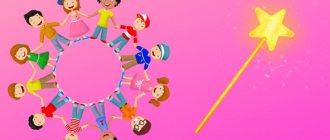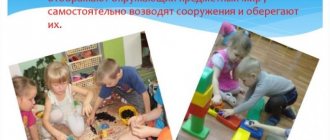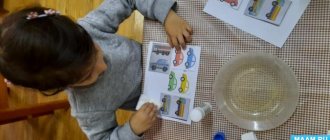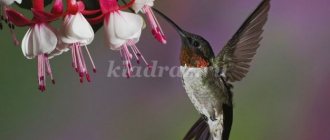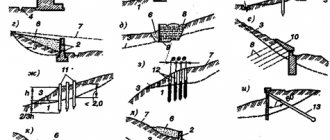When we hear the term “circus competitions for children,” we are surprised and do not believe in the reality of their implementation. After all, physically unprepared children cannot instantly become jugglers, do acrobatic tricks under the circus big top, or skillfully joke with the public like clowns. But fears aside, because circus competitions for children are designed to reveal the creative potential of children, engender artistry and ease of communication with the public. After all, almost every third person in the world is afraid to go on stage because they cannot feel millions of eyes on themselves, play a role, or be embodied in an image. And that’s why circus competitions for children from 5 to 16 years old are considered so valuable.
Circus competitions for children from 5 to 7 years old
"Balloon Juggling"
Equipment: You need a large number of half-inflated balloons made of durable and matte latex.
Rules of the game: Children are invited to rehearse and prepare a circus act in the genre of juggling. It is advisable that music be played in the hall during an impromptu rehearsal. For what? – So that children can not only juggle balloons, but also dance, creating a spectacular performance for their future audience. If possible, you can explain the rules of juggling to boys and girls and show examples of successful performances. You should initially work with two balloons, and when everything works out, then pick up a third one. During rehearsal breaks, you can organize battles, choosing the two most diligent “circus performers” from the team, bring them onto the stage, and let them juggle for a while. Whoever's balls fall to the ground loses. If desired, you can arrange a gala concert.
Recommendations: A circus competition can become one of the elements of a large-scale children's holiday, a physical activity at school, kindergarten during a break between intellectual activities.
"Rope Walker"
Equipment: a long rope of small diameter, as well as pins for finishing points, a fan or a long cane for balance.
Rules: There is no need to hang the rope, you just need to place it on a flat floor surface, mark the beginning and end of the rope walker’s path with pins. And during the game, each of the participants will put on shoes, pick up a fan or cane for balance and walk along the rope. The task is to walk beautifully without losing balance, doing tricks, for example, jumping, standing on one leg, doing a “swallow”, squatting and much more. The jury evaluates artistry, grace, and ease in performing tricks. The reward may be applause or sweet prizes.
Recommendations: It is advisable to conduct all circus competitions for children for micro groups. If the performance drags on, the children will begin to get bored, make noise, and get distracted, so it won’t be a colorful performance.

Physical education entertainment for children in the preschool group of preschool educational institutions
Physical education entertainment in the preparatory school group “TODAY THE CIRCUS IS ON OUR VISIT”
Physical entertainment for children of the preparatory group of preschool educational institutions.
The material may be useful to physical education instructors in preschool educational institutions and teachers.
Author: Leiko Galina Anatolyevna music director of MKDOU kindergarten No. 8 in Ostrogozhsk. Health objectives: To develop the skills of correct posture, developing the musculoskeletal system; Strengthen the respiratory organs and abdominal muscles; Develop the basic functions of the vestibular apparatus. Educational objectives: To consolidate the skills of walking and running in a column one at a time; walking on toes, on the outside of the foot; performing exercises with objects (soft sticks); crawling on a bench on your stomach. Develop a sense of rhythm, coordinate movements with music, performing elements of rhythmic gymnastics; Develop vital motor skills and abilities that promote health; Educational objectives: To develop in children the ability to show determination and self-confidence; Develop the ability to overcome physical difficulties, cultivate patience and endurance; Influence the development of a sense of beauty, lightness, grace. Equipment: arcs (4), sandbags (according to the number of children), soft colored sticks (according to the number of children), walkers (4), “throwers”, a box, balls with riddles, soft toys (elephant, monkey, hippopotamus, bear , tiger, lion, snake), candy. The entertainment is accompanied by musical accompaniment.
Progress of entertainment.
Children go into the hall and line up. Educator. Today is a performance for adults and children! Merry circus, Merry circus has arrived, To kindergarten! Everyone is happy to see the artists, Everyone goes to the parade! The “Circus” march sounds (Introductory part: walking in a column one at a time, on toes, on the outside of the foot, running straight, side gallop, running “snake”, imitative movements “cow”)
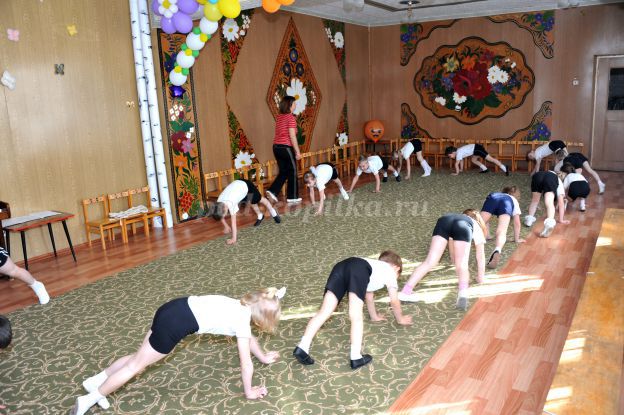
Educator. Everyone is looking at the middle. In the middle there is magic: There the eccentric took a little bunny out of his pocket. There, under the dome, a dancer flew away like a tit. The dogs danced there... You, of course, have been there. Guys, do you know what a circus is? (Conversation with children about the circus: what is the name of the place where the circus performers perform, what is the shape of the circus arena, what are the names of the artists working in the circus). Children sing the song “Today the circus is visiting us.” The whistle sounds and the clown Klepa appears to the music. He pulls a large box behind him.
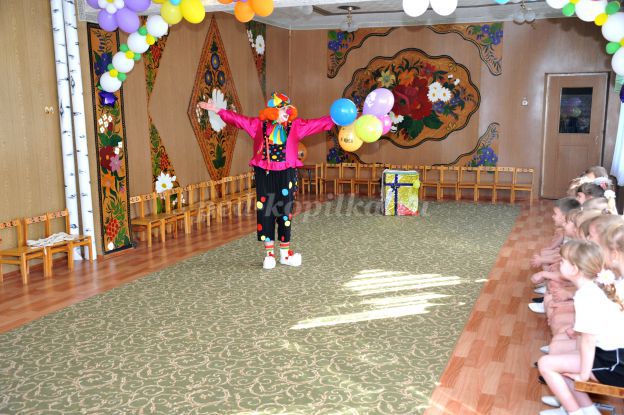
Educator. Children, look who came to us? it's a clown! Klepa. The playpen is on fire! Arena stage! I am the clown Klepa - the athlete's best friend. Hello kids, Hello kids! Did you know that the circus was born almost 200 years ago and at first it was only equestrian. Because the circus showed nothing but horse racing. But now the circus is a holiday in which dexterous, strong, brave and talented artists perform. Do you want to be like them? I've been working in the circus for so long and I've learned a lot. And when I saw you, I immediately realized that I had a young generation growing up! Today I propose to turn into real circus performers. Do you agree? Children. Yes! Klepa. Do you all want to know, friends, what is here in my box? Parade-alley! Let's start the rides! And it’s okay that you are not champions. Educator. We can learn everything, it will be very useful to us in life! Klepa. Take all the sticks apart and start training. (The clown pulls out colored sticks from the box, fastened into one long one. Children take them apart and stand scattered) General developmental exercises with flexible sticks.
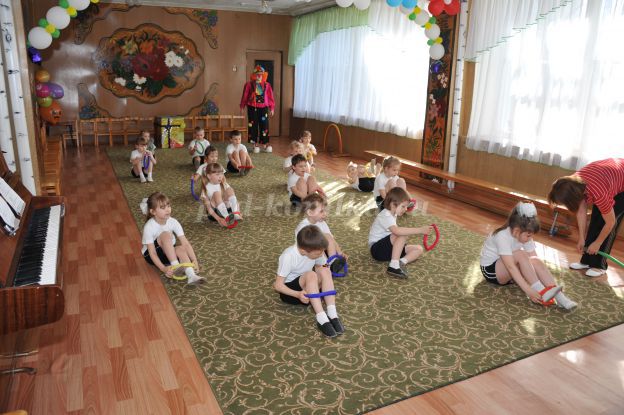
Main types of movements: Riveting. Do you want to become a giant? You need to stand on stilts! (takes out a walker from the box) Teacher. Taller than dad, taller than mom, Let's help ourselves become. We will only take stilts, We will break the record in height. Walking with a walker
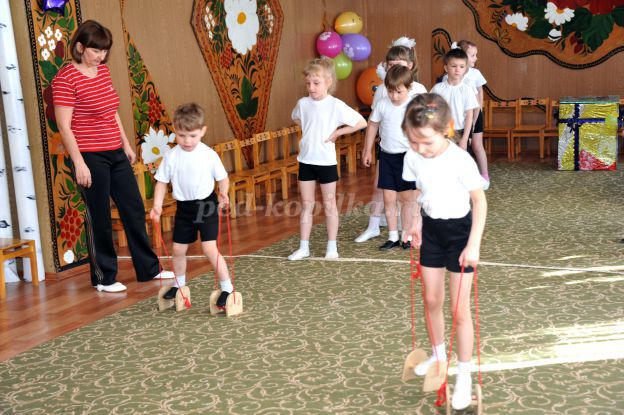
Kepa. Of course, he is larger than a hedgehog, and the spines are longer. I saw it once at the zoo... Who is it? (Porcupine) Crawling on all fours with a load on the back (imitative “hedgehog” movements)
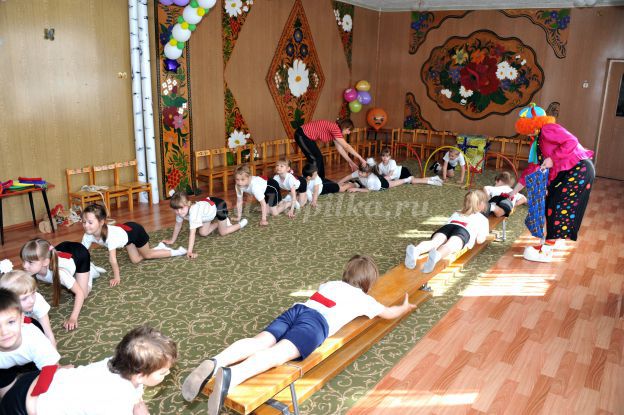
Klepa. Well done! That's it, it's decided, I'm taking you to work at the circus! (turns to the children mockingly)
Oh, you probably don’t know that not only people work in the circus, but also...
Children. Animals! Klepa. Absolutely right! And they came with me today. Do you want to see them, aren’t you afraid? Then guess the riddle! Here they are, my riddles. (The clown takes balloons out of the box). Klepa. To get that riddle, you need to ride on the ball. Whoever gets the riddle faster is a brave man! Brave guys, go ahead, a test awaits you.
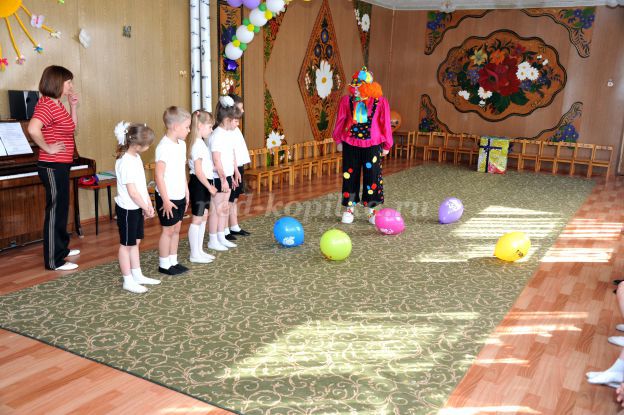
With huge ears and tusks in an arc, Walks through the savannah like a big giant , And he will be able to clean himself with his trunk, There is no one stronger than the African...
(Elephant)
The beast waddles through raspberries and honey.
He loves sweets very much. And when autumn comes, He climbs into the hole until spring, where he sleeps and dreams. (Bear)
Walks in a striped skin, Digs the ground with a strong paw, Harmless in the picture, But dangerous even in the circus!
He is not an affectionate kitten, but a serious beast... (Tiger cub)
The king of beasts is a big cat, he growls a little out of anger.
He sleeps in the den, having eaten, wears a mane, is formidable... (Lion)
Clumsy and large, He grazes under water.
Stuffing his belly, Nibbles grass... (Hippopotamus)
Makes faces, the crooked beast, Mimics everyone.
In the circus or zoo, her success is guaranteed. (Monkey)
The ornament writhes.
Don't make him angry - he will sting! (Snake) Klepa. But this is my... Manyunya (calls the snake that)
She’s angry with me.
Aren't you scared? Children. No! (The clown takes out of the box a snake tied by a fishing line. The snake, controlled by the fishing line, “jumps” on the clown. He gets scared and runs away, the snake “catches up” with him)
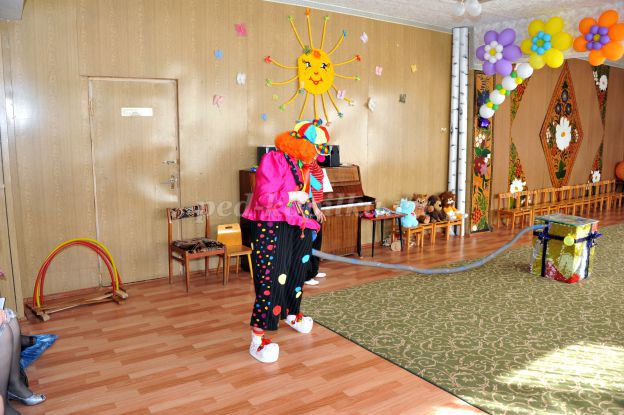
As a result, the Clown hides the snake in a box and sits on it.

Klepa. Oh oh oh. And you say it’s not scary. Educator. Don’t be upset, Klepa, but play a game with the guys. It's about you, it's called "Clown". “Clown” (finger game)

the kids really like him.
- three claps.
Nose like a red tomato.
- they stroke their nose with their hands,
and there is enthusiasm in his eyes.
- with the help of hands they depict eyes and clap their eyelashes - fingers.
Tears flow like from a faucet -
“collect the tears in the palm.”
In multi-colored pockets.
– show palm-to-hip pockets.
And in the pockets, here and there,
the hands are folded into a “bud”, raised up, and the “petals” open.
Red roses are growing.
Now he cries, now he laughs - index fingers vertically to his eyes, then to his lips.
Either he is kind, or he fights—
they stroke their hands, then throw their fists forward.
Oh, how clumsy he is -
his hands on his belt, his body tilting left and right.
But that’s how everyone needs him.
– arms are crossed on the chest, to the sides and on the belt. Klepa. Oh, what a kid, I’ll play with you! It’s true that I’m afraid to open my box, in case my Manyunya isn’t sleeping. (He carefully looks into the box and takes out the “throwers”). Game "Throwers". (A net is stretched across the center of the hall. Children are divided into two teams and positioned on different sides of the net. The game begins and ends with a whistle. The throws are thrown over the net. At the end, the children count the number of throws on their side. The team that has fewer on its side wins thrower. The game is played several times)
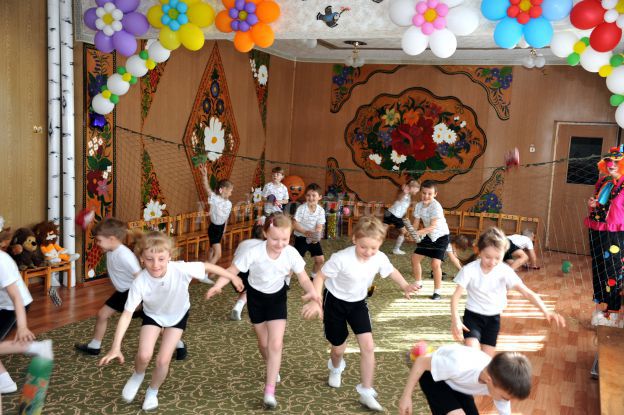
Klepa. How you played fun and together. Well done! For this I will give you one magic ball. Come on, help me, bring the box.
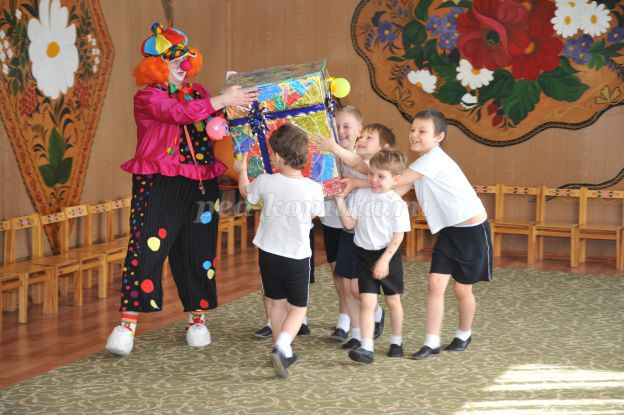
Klepa takes a ball out of the box and invites the children to his place. Throwing the ball up, he pierces it and candy falls on the children.
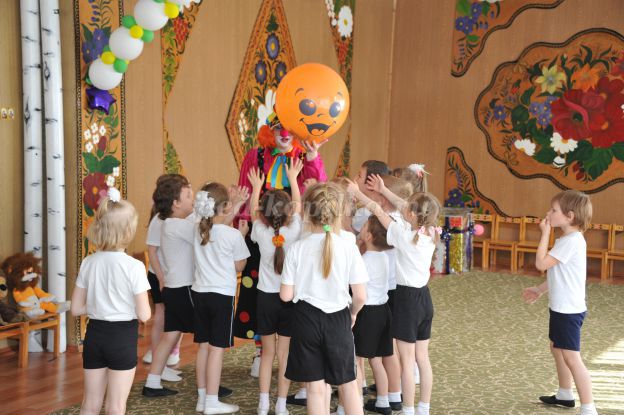
Klepa. Circus is fun and success. And cheerful children's laughter! Educator. We will clap our hands, Because we love everyone! Goodbye, Clown Klepa. Children. Goodbye! The children walk through the hall to the music and say goodbye to Klepa.
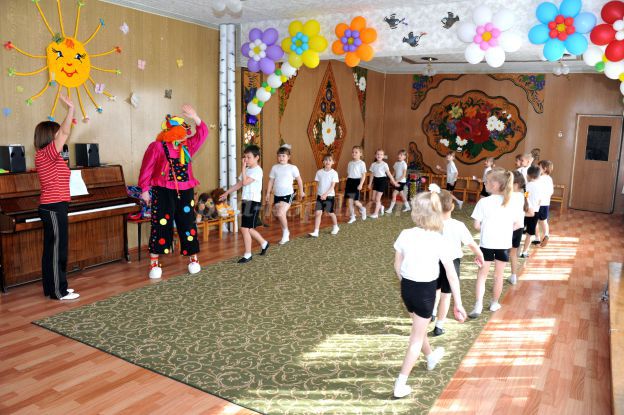
Children leave the hall to the music.
We recommend watching:
Physical education entertainment for children of the preparatory group. Scenario: Physical education entertainment for children of the senior preparatory group. Scenario: Physical education entertainment in kindergarten together with parents. Preparatory group Synopsis of a physical education lesson “Winter fun” for children of the senior group in kindergarten
Similar articles:
Physical education leisure in the preparatory group in the winter in the hall
Circus competitions for children from 8 to 12 years old
In children of primary school age, coordination of movements becomes better, so circus competitions for children gradually become more complex and increase in time period. They are usually used for New Year's holidays, birthdays and other grand celebrations that involve the convening of a large number of guests, participants, and spectators. So what competitions can we recommend for boys and girls studying in elementary school?
"Experienced trainers"
Equipment: a large number of soft toys in the form of wild or domestic animals. The main thing is that they are stable and have a long neck and a small head. Circus rings or plastic hoops.
Rules: A circus arena is being prepared for the trainer, that is, soft toys are placed on the stage along the perimeter of the circle at an equal distance from each other. And the participants will approach the center of the arena one by one, holding identical sets of hoops in their hands. The task of each trainer is to throw circus rings or hoops on all the animals one by one. The jury counts the number of hits and determines the winner and the most experienced trainer.
Instructions: Additionally, you can use circus costumes to make the event colorful and solemn. There must be background music in the hall; it will encourage both the participants, fans and spectators.

"Funny Stilts"
Equipment: improvised stilts, these can be plastic cubes with ribbons tied at the edges.
Rules of the game: Children are given improvised means from which they can construct stilts. Usually children tie ribbons to the cubes, lift the free ends up and hold them with their hands. Afterwards, a relay race is organized, when two kids try to reach the finish line at speed on improvised stilts.
Instructions: For improvised stilts, it is better to choose durable plastic so that it does not break under the baby’s weight and injure his leg. And the ribbons or ropes should be wide and long so that participants of different heights can comfortably fit on stilts, while holding them with their hands using available means.
about Meeple Circus
Meeple Circus is a skill game for 2 - 5 players from Matagot. For the game's author, Cédric Millet, this is his debut in tabletop game design. Most recently, the publishing house Lavka Igrii announced the localization of the game in Russia, and even with two additions at once.
Unexpectedly, I was able to get acquainted with the game even before localization. This article will be an impression of the first game in Meeple Circus.
In this game we are greeted by a mountain of colorful figures - meeples, and other wooden parts - boards, cylinders, tablets. Usually, when such a set lies on the table, hands reach out to assemble some complex figure from them - a pyramid or a tower. True, at this time your friend explains the rules and gets angry at you for ignoring him.
So, in the Circus you can not only build towers from meeples, you need to build them, because this is the essence of the game.
Game process
The game lasts three rounds. At the beginning of each round, players distribute resources among themselves. All the wooden elements are the resources here. The choice occurs through a simple draft of cardboard tiles. The interesting thing is that everyone will take one white token, which is simpler, and one red token, which is more sophisticated. They differ in that the figures from the red token must be present in the arena during the performance, and from the white token they can profile.
You have to choose based on the task cards. They show which acrobatic tricks are in favor today, that is, they are rewarded with victory points. It is not necessary to complete everything, and it will not be possible, but you should try to stock up on resources in order to complete most of the tasks.
Let me remind you that the game lasts three rounds, two for rehearsals and the third for the audience. Accordingly, the red tokens in each round are more and more interesting: if in the first there is a rare elephant, then in the second there is a unique strongman, showman or other circus performers who even have their own face. They bring with them bonuses and can bring additional victory points. The third round is quite interesting - in front of the audience, the players are required to comment on the performance with compliments, accompany them with drumming (that is, build figures with one hand and drum on the table with the other), or do something else besides building pirouettes.
Actually, the second part of each round is the performance. It differs from ordinary games of skill in that it happens in real time: the phone application plays music for each of the rounds, which measures the start and finish, after which the acrobats can no longer be touched.
Well, then the prose of life in games for victory points - everyone checks what tricks they managed to perform, how tall their tower is, which meeples fulfilled their conditions for additional points.
Impression
How can you approach a game of skill? The first thing you expect is something childish. Secondly, what’s so interesting about building a turret? Both expectations are not met.
It may be a children's game, but the parts for construction are small enough that it would be difficult for an adult to assemble a solid structure from them. I think on the contrary, the smaller the child, the more difficult it will be for him to concentrate and build something worthwhile in a short limited period of time.
This is one of the reasons for an interesting game. Not the easiest challenge for shaking hands, and they involuntarily begin to shake when you place the tenth small figure on your tower and are afraid to take an extra breath. The agility of your opponents also motivates - if they haven’t built a high figure, then you yourself relax. True, there is almost no time to look at their work during the hour of performance. Therefore, you don’t relax much, immersing yourself in your process. In addition, the excitement of building a single structure, because its height will give additional points, does not always outweigh the value of lower, but stronger tricks that correspond to the tasks. It’s harder for them to fall.
And in the end, you leave the table surprised by the fact that all the adults liked the “children’s game of dexterity” and it was very fun and playful. Now, if only they were drunk and knew all the figures
. I'm ready to play it more than once to see how much more fun it will be. But this story is no longer about first impressions.



